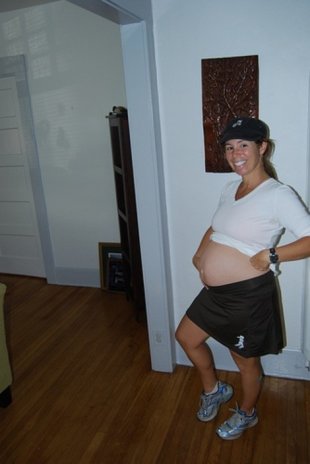
7 myths about prenatal exercise
But there are a lot of myths circulating about prenatal exercise, scaring women off from being active. I'd like to tackle each myth, debunking it with a mix of research and personal experience …

If you weren't active before pregnancy, you can't be active now
1. If you weren't active before pregnancy, you can't be active now
It's common belief that if you did (blank) before pregnancy, you can (blank) during your pregnancy. While helpful to those who've always been active, it can be confusing to those women who don't know where to get started. What if I used to be a runner, and I haven't laced up in a year? What if I wasn't too active - how much is safe now?
According to Raul Artal, MD, lead author of the American College of Obstetricians and Gynecologists' (ACOG) guidelines on prenatal exercise, "nowhere in the medical literature does it say that moderate exercise such as walking is unsafe, even for previously sedentary women." For normal, healthy pregnancies, Artal recommends walking 30 to 60 minutes a day, broken up however you'd like. The ACOG recommends that previously inactive women should start slowly - beginning with as little as 5 minutes of exercise a day and adding 5 minutes each week until they can stay active for 30 minutes a day.

The most important areas to focus on are your pelvic floor, hips, and back
2. The most important areas to focus on are your pelvic floor, hips, and back
I'm not sure where I read this during my pregnancy, but I focused all of my prenatal strength training on hip flexor and lower-back exercises - thinking it would strengthen the area needed for labor. But then I actually went through labor, and little did I know that it actually works every muscle in your body - even muscles you didn't know you had. (Not to mention you'll spend the next year carrying a heavy car seat/infant/diaper bag.)
Speaking from personal experience, I urge you to strengthen your arms, legs, and core as well. As long as your pregnancy isn't considered high-risk, doing some strength training is completely safe. A recent study conducted by the University of Georgia followed a group of pregnant women, between weeks 21 and 25, for 12 weeks as they weight-trained (with supervision) two days per week. No one was injured. However, it's important to note that you should stop lifting weights at the first sign of dizziness. Overexertion is not healthy for anyone!
Related: Prenatal fitness - 10 safe exercises to do during pregnancy

Ab exercises are out of the question
3. Ab exercises are out of the question
In an interview with Fit Pregnancy, prenatal fitness trainer Sara Haley said that doing crunches on your back is a no-no because "your growing uterus can compress the vena cava, the major vessel that returns blood to your heart, potentially reducing blood flow and making you feel dizzy and nauseated." But, she reassures, there are plenty of ways to work out your core by standing, kneeling, or using a stability ball. In fact, Haley performed the plank move until the day she gave birth (which she was very thankful for during those last two hours of labor).

Exercising can cause miscarriage
4. Exercising can cause miscarriage
A Danish study of 92,000 women showed no increase in miscarriage from exercise performed after 18 weeks. Before 18 weeks, an increase in miscarriage was found only in women who intensely worked out more than 7 hours per week with high-impact activities. As long as your healthcare provider approves your exercise plans, you can rest assured that you'll actually be doing your body a favor rather than putting it at risk; prenatal exercise can actually reduce some symptoms of pregnancy, such as back pain and other discomforts.
So while experts still can't say for sure, it's best to stick to low-impact activities in the first 18 weeks, stay hydrated, and avoid excessive huffing and puffing. It's also a good idea to avoid exercising in the heat so that your core body temperature isn't raised too high.
Related: 8 tips for safe prenatal workouts

Don't work out more than 3 times a week
5. Don't work out more than 3 times a week
According to Lisa Druxman, a pre- and postnatal fitness expert and founder of Stroller Strides, "Following a doctor's approval, it's recommended that pregnant women engage in 30 minutes or more of moderate exercise daily, five or more times a week." (This includes everything from walking down the road to climbing stairs.) The ACOG agrees, recommending exercising and being active "at least 30 minutes on most, if not all, days of the week" to help physical ailments (constipation, backaches, swelling, etc.) and medical conditions (like gestational diabetes), and to help cope with labor and recovery. The ACOG also cites improved mood, energy, and sleeping as reasons to exercise.

Your heart rate shouldn't go over 140 beats per minute
6. Your heart rate shouldn't go over 140 beats per minute
Although this used to be a common recommendation from the ACOG and OBGYNs, women's heart rates vary too widely to stick to this rule. The ACOG now recommends that women use the "Borg Scale" (or the talk test) to determine physical exertion: during moderate activity, you should be able to talk (but not sing) through an activity. Learn more from the CDC guidelines on measuring physical activity intensity.
Related: Top 10 reasons why I got my tubes tied

Pregnant women should only do low-impact activities
7. Pregnant women should only do low-impact activities
Yes, pregnancy causes the hormone relaxin to loosen your ligaments to prepare for labor, but you don't need to limit yourself to water aerobics and the elliptical machine from the get-go. Of course there will probably come a time when jogging will feel uncomfortable, but according to fitness instructor Nicole Nichols for BabyFit.com, you can easily modify most pre-pregnancy fitness routines throughout your pregnancy - even spin classes and Pilates - with advice from your instructor. Your body will also tell you its limits, so just pay attention to how you're feeling.
There are some exercises, however, that are off limits. The ACOG recommends avoiding high-risk activities, such as gymnastics, water skiing, and horseback riding, and contact sports, such as hockey, basketball, and soccer. They also recommend avoiding scuba diving because of decompression sickness, and downhill skiing because it shifts your center of gravity and puts you at risk of altitude sickness.
Bottom line: Talk to your doctor, stay hydrated, and always listen to your body. But above all else - start moving!
- By Michelle Horton
For 3 more debunked myths about prenatal exercise, visit Babble!
MORE ON BABBLE
12 ways to sneak more workout time into your day
8 unexpected benefits of exercise
What you should NEVER say to a pregnant woman
10 things every woman should do before having kids
No harm, no foul: 10 "unsafe" things I did while pregnant
Stay connected. Follow Babble on Facebook and Twitter.
No comments:
Post a Comment